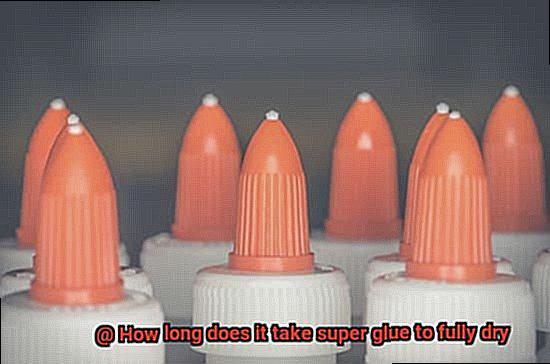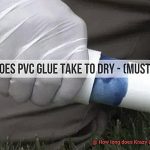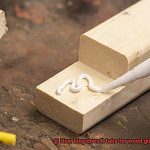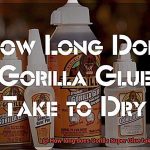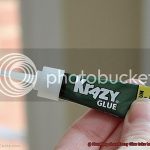Ever found yourself in a sticky situation? Super glue to the rescue.
It’s the ultimate quick fix for broken things, from mugs to shoes. But how long does it actually take for super glue to dry?
Buckle up, because we’re about to uncover the secrets of this magical adhesive. Knowing its drying time is key to nailing your DIY projects and making sure everything sticks together – pun totally intended.
So, let’s jump right in and discover the fascinating world of super glue.
What is Super Glue?
Contents
- 1 What is Super Glue?
- 2 Factors That Affect Drying Time
- 3 How Long Does Super Glue Take to Dry?
- 4 How Long Does Super Glue Take to Cure?
- 5 Temperature and Humidity Effects on Drying Time
- 6 Following Manufacturer Instructions
- 7 Using Accelerators or Activators for Faster Curing
- 8 Precautions To Take During Drying Process
- 9 Conclusion
Prepare to be amazed as we dive deep into the world of Super Glue, the extraordinary adhesive known for its unmatched bonding capabilities. From lightning-fast adhesion to temperature resistance, we’ll explore the various aspects that make Super Glue a game-changer in the realm of bonding.
Lightning-Fast Bonding:
In the blink of an eye, Super Glue lives up to its name by creating an unbreakable bond within seconds. Its secret lies in cyanoacrylate, a magical ingredient that rapidly polymerizes when exposed to moisture. This process transforms the liquid adhesive into a solid, ensuring quick repairs and time-sensitive projects are no match for Super Glue.
Versatility:
Super Glue is an adhesive superhero that can bond an extensive range of materials. Wood, metal, plastic, ceramic, rubber, and certain fabrics all succumb to its power. Whether you’re a DIY enthusiast, a craft lover, or a professional, Super Glue is the go-to tool for all your bonding needs. However, it’s essential to remember that not all surfaces are compatible with Super Glue’s incredible strength.
Temperature Resistant:
Extreme heat or freezing cold? No problem for Super Glue. With exceptional temperature resistance, this adhesive triumphs over challenging environments. It fearlessly withstands the harshest conditions, making it perfect for outdoor applications or bonding objects exposed to varying temperatures.
Invisible Bonds:
Say goodbye to unsightly glue marks with Super Glue’s invisible bonds. Applied with precision, this adhesive dries clear and seamless, preserving the aesthetic integrity of your projects. No evidence of glue interference remains as you marvel at the flawless results achieved with Super Glue.
Choosing the Right Formulation:
Super Glue offers different formulations tailored to specific needs. Liquid Super Glue is the all-purpose adhesive, excelling in general bonding tasks. Gel formulas provide better control and work wonders on vertical surfaces or porous materials. For larger areas or irregular shapes, the convenience of Spray Super Glue is unbeatable.
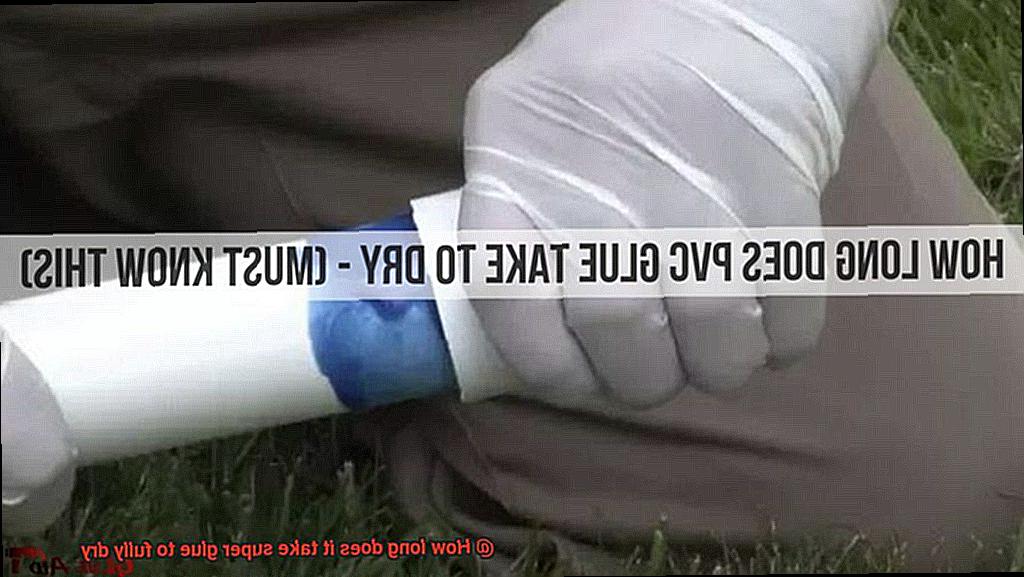
Factors That Affect Drying Time
Unlocking the Secrets of Drying Time: Factors That Influence How Quickly Things Dry
Introduction:
Welcome to the fascinating world of drying time, where we delve into the factors that can speed up or slow down the drying process. Whether you’re waiting for paint to dry, glue to set, or clothes to air dry, understanding these factors will help you plan your projects more effectively and avoid frustrating delays.
Type of Substance:
Different substances have different properties that affect their drying time. For example, oil-based paints take longer to dry than water-based paints because they need to undergo a chemical reaction with oxygen in the air. Similarly, some adhesives, like super glue, have varying formulations that determine their drying time. Choosing the right type of substance for your project is crucial for achieving the desired results within a reasonable timeframe.
Temperature and Humidity:
Temperature and humidity play a significant role in drying time. Higher temperatures accelerate evaporation, speeding up the drying process. Conversely, lower temperatures slow down evaporation and prolong drying time. Humidity also affects drying time, as moisture in the air can hinder evaporation. Working in a well-ventilated area with moderate temperature and humidity levels is ideal for optimal drying.
Thickness or Amount Applied:
The thickness or amount of substance applied can impact drying time. A thicker layer takes longer to dry because moisture needs to evaporate from both the surface and deeper layers. Applying a thin, even layer promotes faster drying as it allows for quicker evaporation.
Porosity of Surface:
The porosity of the surface being dried also affects drying time. Porous materials, such as wood or fabric, absorb moisture, which slows down evaporation and extends drying time. Non-porous surfaces like glass or metal allow for faster evaporation and quicker drying.
Air Circulation:
Good air circulation is essential for efficient drying. It helps carry away moisture and promotes evaporation. When drying items, ensure that there is sufficient airflow around them to expedite the process. Using fans or opening windows can help improve air circulation and reduce drying time.
Chemical Reactions:
Some substances require a chemical reaction to dry properly. For example, epoxy resins and certain paints need to undergo a curing process, which involves a chemical reaction between different components. This curing process can significantly impact drying time, sometimes taking hours or even days.
How Long Does Super Glue Take to Dry?
Super glue, also known as cyanoacrylate adhesive, is a remarkable adhesive that can bond materials together in a matter of seconds. However, the drying time of super glue can vary depending on several factors.
First and foremost, the type of super glue used will impact the drying time. Different brands and formulations may have varying drying times. Some super glues become tacky within seconds, while others may take a few minutes to dry. It is always recommended to check the instructions on the packaging for specific guidance.
Another factor that affects drying time is the materials being bonded. Porous materials like wood or fabric can absorb some of the glue, leading to a slower drying time. On the other hand, non-porous materials like glass or metal allow the glue to dry faster.
Environmental conditions also play a significant role in the drying process. Higher temperatures and lower humidity speed up drying time, while colder temperatures and higher humidity slow it down. So if you’re eager to see your project dry quickly, finding a warm and dry spot can help expedite the process.
The thickness of the adhesive layer is yet another factor to consider. Thicker layers take longer to dry compared to thin layers, so it’s important to apply an appropriate amount of glue for optimal results.
However, it’s crucial to note that even if super glue appears dry after a short period, it may not have reached its full strength. It is best to wait at least 24 hours before subjecting your creation to any stress or load.
Lastly, there are specialized variants of super glue available for specific applications. These variants may have different drying times and properties, so it’s essential to read the instructions for optimal results.
How Long Does Super Glue Take to Cure?
Super glue, also known as cyanoacrylate adhesive, is a powerful bonding agent that can bring materials together in a flash. But how long does it take for super glue to fully cure? Prepare to delve into the world of super glue curing time and discover its secrets.
The curing time of super glue can vary based on several factors. First and foremost, the type of super glue being used plays a significant role. Most super glues on the market have a relatively fast curing time, ranging from a few seconds to a few minutes. However, it’s important to note that while the adhesive may appear dry to the touch within seconds, it may take longer for the bond to reach its ultimate strength.
Another factor that affects curing time is the materials being bonded. Different materials possess various surface properties that influence how well the super glue adheres and cures. Porous materials like wood or fabric may absorb some of the adhesive, thereby slowing down the curing process. Conversely, non-porous materials like glass or metal provide a smooth surface for the glue to bond quickly.
The surrounding environment also plays a pivotal role in super glue curing time. The presence of moisture is crucial for the curing process. In low-humidity environments or situations where there is limited air access, such as tightly bonding two surfaces together, the curing time may be extended. Thus, if you find yourself in a dry environment or trying to bond surfaces with limited air exposure, be prepared to exercise patience as you wait for the glue to cure.
Temperature is another environmental factor that impacts curing time. Higher temperatures generally accelerate the curing process, while lower temperatures slow it down. If you’re working in a chilly room, consider cranking up the heat or utilizing specialized quick-setting super glue that can cure in mere seconds.
To ensure optimal curing, it’s important to clean and dry the surfaces being bonded before applying the super glue. This step removes any contaminants that could interfere with the bonding process and allows the adhesive to form a robust bond.
While most super glues reach their full strength within 24 hours, it’s advisable to wait at least that long before subjecting the bond to stress or heavy loads. This waiting period provides the adhesive ample time to fully cure, resulting in a strong and durable bond.
Temperature and Humidity Effects on Drying Time
Super glue, that marvelous adhesive that comes to our rescue when things fall apart. But have you ever pondered why it takes longer for super glue to dry on a chilly winter day or in a steamy bathroom? Today, we embark on an expedition into the captivating realm of temperature and humidity and their profound influence on the drying time of super glue.
Temperature: The Speed Demon
Humidity: The Moisture Conundrum
Now let’s delve into the enigma of humidity, or as I like to dub it, the perplexing moisture conundrum. When humidity levels soar, the air becomes drenched with moisture, creating a sticky situation for super glue. The surplus moisture renders it challenging for the glue to evaporate, resulting in an extended drying time. Fear not, dear reader. When humidity is low, the glue dries faster than a cheetah chasing its prey. The scarcity of moisture enables swift evaporation and facilitates the achievement of that robust bond you crave.
Finding the Sweet Spot:
What is the secret formula for perfect drying time? Let me enlighten you, my friends – it all boils down to balance. Super glue thrives neither in scorching heat nor icy cold; it thrives in moderate temperatures ranging from 70-80°F (21-27°C). This cozy temperature range allows the glue to work its magic efficiently. As for humidity levels, a relative range of 40-60% keeps the glue content and ensures the most desirable drying times.
Following Manufacturer Instructions
Today, we’re going to explore why it’s absolutely crucial to follow those manufacturer’s instructions. Trust me, this isn’t just some mundane fine print – it’s the secret recipe for achieving the best possible outcome.
Let’s start with the basics. Super glue is a remarkable adhesive that can bond almost anything together in a matter of seconds. But here’s the catch – not all super glues are created equal. Different brands have different formulas and drying times, so it’s absolutely crucial to refer to those specific instructions from the brand you’re using. Here’s why:
- Drying Time: Ah, the golden rule of super glue – drying time. The manufacturer’s instructions will give you the lowdown on how long it takes for that magical glue to set. Some may dry in seconds, while others might need a few minutes. By following these guidelines, you’re ensuring that your project has the optimal time to bond properly.
- Bonding Tips: Manufacturers are like glue wizards – they know all the tricks of the trade. Their instructions often include extra tips on how to achieve the strongest bond possible. They might suggest applying a thin layer or advise against bonding certain materials. These little nuggets of wisdom can make a huge difference in the success of your project.
- Strength Matters: We all want our glued creations to stand the test of time, right? By following the manufacturer’s instructions, you’re giving your super glue the best chance to provide a strong and durable bond. Skipping those instructions might result in a weaker bond or even longer drying times – nobody wants that.
- Temperature and Humidity: Now, let’s talk about the impact of temperature and humidity on drying time. Each brand might have different recommendations for optimal conditions, so pay attention. Higher temperatures can speed up the drying process, while high humidity levels can create a sticky situation. Find that sweet spot, and your glue will thank you.
But what if you can’t find those instructions or they’re as clear as mud? Don’t fret. Reach out to the manufacturer for further guidance. They’re the glue experts after all, and they’ll be more than happy to help you out.
Using Accelerators or Activators for Faster Curing
That’s where accelerators or activators come into play. In this article, we’ll explore the advantages and disadvantages of using accelerators or activators with super glue, giving you the inside scoop on how to achieve lightning-fast results.
Advantages:
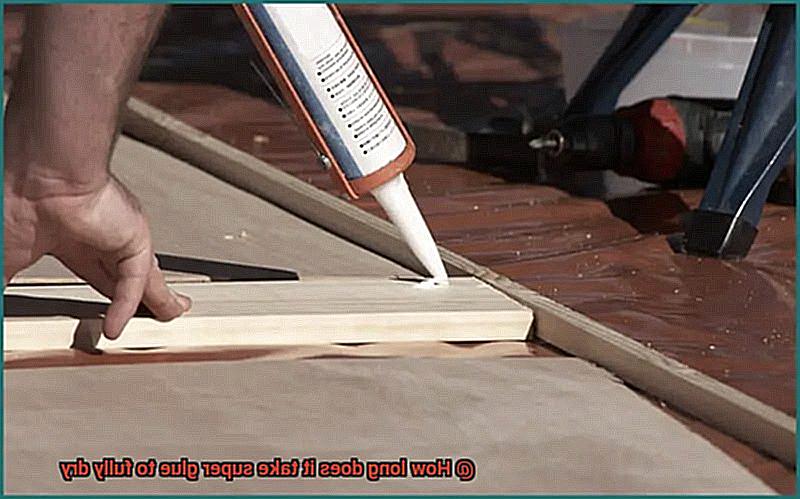
- Speedy Bonding: Accelerators or activators dramatically reduce curing time by promoting a rapid chemical reaction. These products can help your super glue dry in seconds, saving you valuable time on your projects.
- Enhanced Bond Strength: In addition to speeding up the drying process, accelerators and activators improve the overall bond strength of the adhesive. This means your glued surfaces will be more secure and resistant to stress, ensuring long-lasting results.
- Increased Versatility: Some accelerators are specifically designed for certain types or brands of super glue. This versatility allows you to tailor your choice of accelerator based on your specific project needs, ensuring optimal performance.
Disadvantages:
- Limited Working Time: One potential drawback of using accelerators is that they can significantly reduce the working time of super glue. This means you’ll have less flexibility to adjust or reposition your bonded surfaces once the glue has been applied. It’s crucial to work quickly and precisely when using accelerators to avoid any mishaps.
- Chemical Hazards: Accelerators and activators often contain chemicals that can be harmful if not used correctly. It’s important to follow the manufacturer’s instructions, wear protective gear, and work in a well-ventilated area to minimize any potential risks.
- Compatibility Issues: Different brands and types of super glue may require specific accelerators or activators. It’s essential to read the instructions provided by the manufacturer to ensure compatibility and achieve the desired curing results.
Using accelerators or activators with super glue can be a game-changer for those seeking faster curing times. The advantages include lightning-fast bonding, enhanced bond strength, and increased versatility.
However, it’s important to consider the limited working time and potential chemical hazards associated with these products. By following the manufacturer’s instructions and taking necessary safety precautions, you can harness the power of accelerators or activators to achieve professional-grade results in record time.
Precautions To Take During Drying Process
Super glue is a powerful adhesive that bonds quickly and securely, but it’s important to take precautions during the drying process to ensure both successful bonding and personal safety. In this article, we will explore the essential precautions to keep in mind when working with super glue.
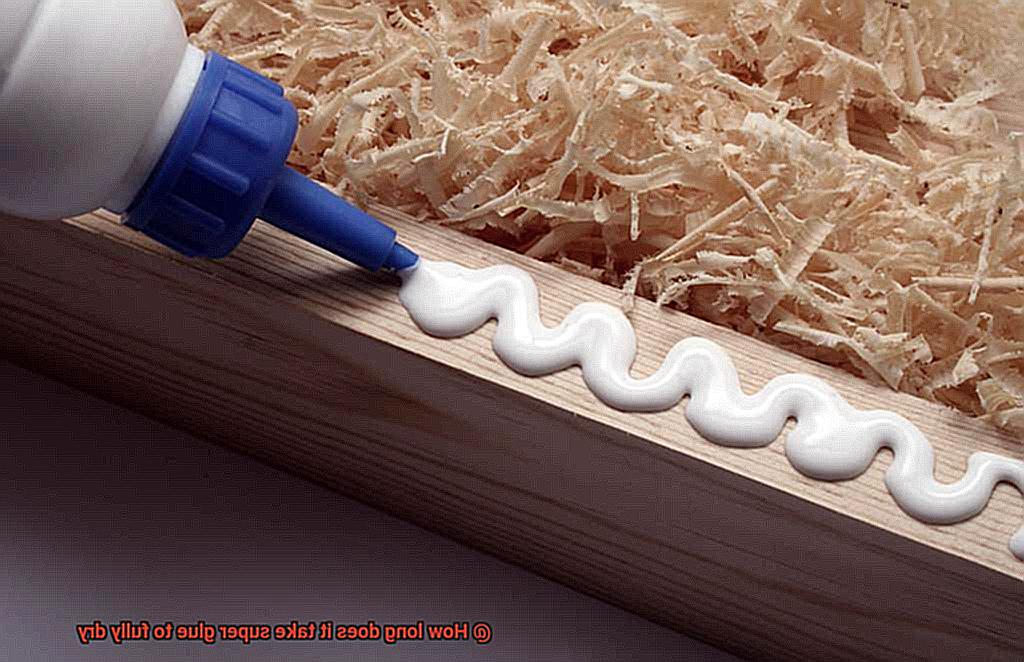
Ventilation:
To protect yourself from harmful fumes released during the drying process, always work in a well-ventilated area. Open windows or use fans to improve air circulation while using super glue.
Eye and Skin Protection:
To avoid irritation and injury, wear safety goggles or glasses to protect your eyes from accidental splashes or drips. Consider wearing gloves or applying a barrier cream on your hands and fingers to prevent direct contact with the glue.
Clothing Protection:
Protect your clothes from permanent stains or damage by wearing old or protective clothing while working with super glue. If any spills occur, immediately remove the affected clothing and rinse with warm water before the glue dries.
Keep Children and Pets Away:
Keep super glue out of reach of children and pets at all times. During the drying process, ensure they are kept at a safe distance to prevent accidental ingestion or exposure to the glue. If any glue gets on their skin or fur, consult a veterinarian or pediatrician for guidance on safe removal.

Avoid Excessive Application:
Use small drops or thin layers of adhesive to prevent longer drying times and minimize the chances of spills or drips. Remember, a little goes a long way with super glue.
Work with Precision:
Plan and position the items you are joining before applying the glue, as super glue bonds quickly. Once applied, hold the pieces firmly together for the recommended drying time to ensure a secure bond.
Clean Spills Immediately:
Clean up accidental spills or drips promptly using a cotton swab or cloth moistened with acetone or nail polish remover. Be careful not to spread the glue further or damage delicate surfaces.
FNQSa3H_E1Q” >
Also Read: How Long Does Super Glue Take to Dry?
Conclusion
Super glue is a handy adhesive that can bond materials together quickly and securely. But how long does it take for this powerful adhesive to fully dry? The answer depends on various factors, including the type of super glue you’re using and the materials you’re bonding.
On average, most super glues take around 10 to 30 seconds to set, meaning they become firm enough to hold the bonded items in place. However, it’s important to note that setting time doesn’t necessarily mean the glue has completely dried.
To achieve full drying and maximum strength, you’ll need to wait a bit longer. Generally, super glue will fully dry within 24 hours. During this time, it undergoes a process called polymerization, where it transforms from a liquid into a solid state.
The drying time can be affected by several factors. For instance, temperature plays a role in how quickly the glue dries. Higher temperatures tend to accelerate the drying process, while colder temperatures can slow it down.
Additionally, the thickness of the glue layer and the type of materials being bonded can also impact drying time. Thicker layers or porous materials may require more time for complete drying.
It’s crucial to exercise patience when working with super glue. Rushing the drying process can compromise the strength of the bond and lead to potential failures later on.
In conclusion, while super glue sets in mere seconds, allowing you to continue working on your project relatively quickly, it takes approximately 24 hours for it to fully dry and reach its maximum strength.

